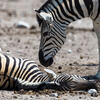You are here
The enduring mystery of consciousness

Consciousness: a simple definition, but a complex measurement
From a subjective standpoint, consciousness seems to be a straightforward concept: it is the state we are in when we are awake. And yet, its scientific nature remains difficult to quantify. The main problem lies in its measurability: how do we determine whether a being, human or not, is conscious?
“If you tell me that you’re conscious, I believe you,” explains Catherine Tallon-Baudry, a CNRS research professor at the LNC2 cognitive and computational neuroscience laboratory in Paris. “But if I’m dealing with an organism that’s unable to say it’s conscious, or an artificial intelligence system that claims to be, I can’t be so sure.”
Consciousness is a subjective state. It cannot be observed directly, unlike measurable biological parameters like blood sugar levels or cardiac activity.

What beings are conscious? And how do we know?
Are humans the only conscious beings? The question is subject to debate in the scientific community. There is no doubt about the intelligence of many species, but intelligence and consciousness are not the same thing.
Certain primates, dolphins and some birds show signs of self-awareness1, in the sense that they seem to recognise themselves in a mirror. But the interpretation of this test remains problematic. Many animals fail it even though they engage in behaviours that suggest a form of consciousness2.
The neurosciences offer another approach: the study of brain activity associated with consciousness3. For example, laboratory tests can explore “vision at the threshold of consciousness”: an individual is shown brief flashes of images to determine at what point they become consciously perceptible. By analysing how the brain processes information, researchers can establish cerebral markers of awareness. These markers can then be measured in comatose patients who no longer communicate with the outside world, to detect the presence of any residual sentience4.
The Vincent Lambert case5 offers a good example of the difficulties in determining whether a person is conscious when they are unable to communicate. But what about animals? Experimental protocols, often reward-based, raise questions: do the subjects’ responses indicate true consciousness or mechanical learning?
Is the brain the only arbiter?
Does consciousness reside solely in the brain? “The entire organism is conscious, not just 1.2 kilos of brain matter,” Tallon-Baudry notes. She supports the idea that consciousness is the result of a complex interaction between the brain and the body – an aspect often overlooked by conventional theories. In the course of multiple studies6, the neuroscientist has demonstrated that the connections between the heart and the brain make it possible to predict both self-awareness and awareness of the outside world.
Combining neuroscience and experimental psychology, the work of CNRS research professor Nathan Faivre at the LPNC7 bolsters this theory. His studies8 have shown that bodily disruptions, such as alterations in corporeal perception, significantly influence our self-awareness and capacity to process sensory information. Faivre’s findings indicate that physical changes can affect our interaction with the environment and alter our entire conscious experience.
A universal theory of consciousness: mission impossible?
Science continues to progress, but with caution. As Tallon-Baudry puts it, “We have hypotheses, but it’s too soon to talk about a theory.” Consciousness is still a young field of study, and the phenomenon itself is exceedingly complex.

Rather than seeking a global explanation, current research focuses on identifying the various components of consciousness and the related biological mechanisms. The path forward will involve breaking the mystery down into a number of more accessible elements.
The philosophical and religious interpretations of consciousness are considered beyond the scope of science. Tallon-Baudry, who identifies herself as a materialist, maintains that research should be limited to what can be studied and measured.
Can artificial intelligence achieve consciousness?
Still, certain questions remain: could an artificial intelligence (AI) system one day reach the point of being conscious? If we define consciousness solely by the ability to process information and exercise reason, some AI systems could already be considered conscious. But if consciousness necessarily implies an organic, subjective and emotional aspect, these machines still have a long way to go.
Jean-Rémy Hochmann, a CNRS research professor at the ISC-MJ9, explores the developmental origins of unique human abilities such as language and logic by studying cognition in infants: “If you ask a mother if her eight-month-old baby is conscious, she will certainly say yes!” he comments. “Indeed, her baby moves around, smiles, laughs, interacts with others and is even starting to babble. But what about a five-month-old child? Three months? A newborn after only a few minutes or hours of life? In those cases, their behaviour is much less controlled, but our research – as well as the work by Ghislaine Dehaene-Lambertz 10 and Sid Kouider 11 – suggests that the basic cognitive and neuronal structures that enable consciousness are in place very early on, perhaps from birth. Still, we have shown that these structures function more slowly in infants, as much as six or seven times slower at five months than for an adult.”

With artificial intelligence becoming more and more powerful and refining its capacity for reasoning, today’s world is nearly reminiscent of the evolution of JARVIS from Marvel comics, Tony Stark’s digital assistant that becomes Vision, an autonomous entity endowed with its own consciousness. It transforms from a simple utility into a being capable of thinking and feeling. Is it pure science fiction? Perhaps. But this metamorphosis raises a very real question: could artificial intelligence one day become conscious?
Consciousness remains one of the deepest mysteries of modern science. Researchers are now trying to unravel its workings by exploring it from various perspectives: sensory perception, self-representation, emotional states, etc. It’s a real puzzle, each piece of which brings us a bit closer to answering that age-old question: what makes us conscious?
For further reading:
Downloading the human mind
AI needs to align with human values
How to speak to extraterrestrials?
The vestibular system, a little-known sixth sense (video – in French)
- 1. “Animal consciousness”, EFSA supporting publication, 2017. https://doi.org/10.2903/sp.efsa.2017.EN-1196
- 2. “The Scientific Study of Consciousness Cannot and Should Not Be Morally Neutral”, Perspectives on Psychological Science, 18(3), 535-543. https://doi.org/10.1177/17456916221110222
- 3. “Neural correlates of consciousness: progress and problems”, Nature Review Neuroscience 17, 307–321 (2016). https://doi.org/10.1038/nrn.2016.22
- 4. “Neural responses to heartbeats detect residual signs of consciousness during resting state in comatose patients”, Journal of Neuroscience, 2021, 41(24) 5251:5262. https://doi.org/10.1523/JNEUROSCI.1740-20.2021
- 5. The Vincent Lambert case in France provides an illustration of the ethical and medical issues related to consciousness. A patient in a state of minimal consciousness sparked a national debate on the end of life, highlighting the difficulty of defining the boundary between consciousness and the lack of consciousness, as well as the implications of this distinction for medical and legal decisions.
- 6. “Interoceptive rhythms in the brain”, Nature Neuroscience 26, 2023, 1670-1684; “Visceral signals shape brain dynamics and cognition”, Trends in Cognitive Sciences, 23 (6), 2019, 488-509. https://doi.org/10.1016/j.tics.2019.03.007
- 7. Laboratoire de Psychologie et Neurocognition (CNRS / Université Grenoble Alpes / Université Savoie Mont Blanc).
- 8. “Visual consciousness and bodily self-consciousness”, Current Opinion in Neurology 28(1):p 23-28, 2015. https://doi.org/10.1097/wco.0000000000000160
- 9. Institut des Sciences Cognitives Marc-Jeannerod (CNRS / Université Claude Bernard Lyon 1).
- 10. CNRS research professor at the language neuroimaging and brain development laboratory (UNICOG – CNRS / CEA / INSERM / Université Paris-Saclay).
- 11. CNRS research professor at the LSCP cognitive sciences and psycholinguistics laboratory (CNRS / EHESS / ENS-PSL).













